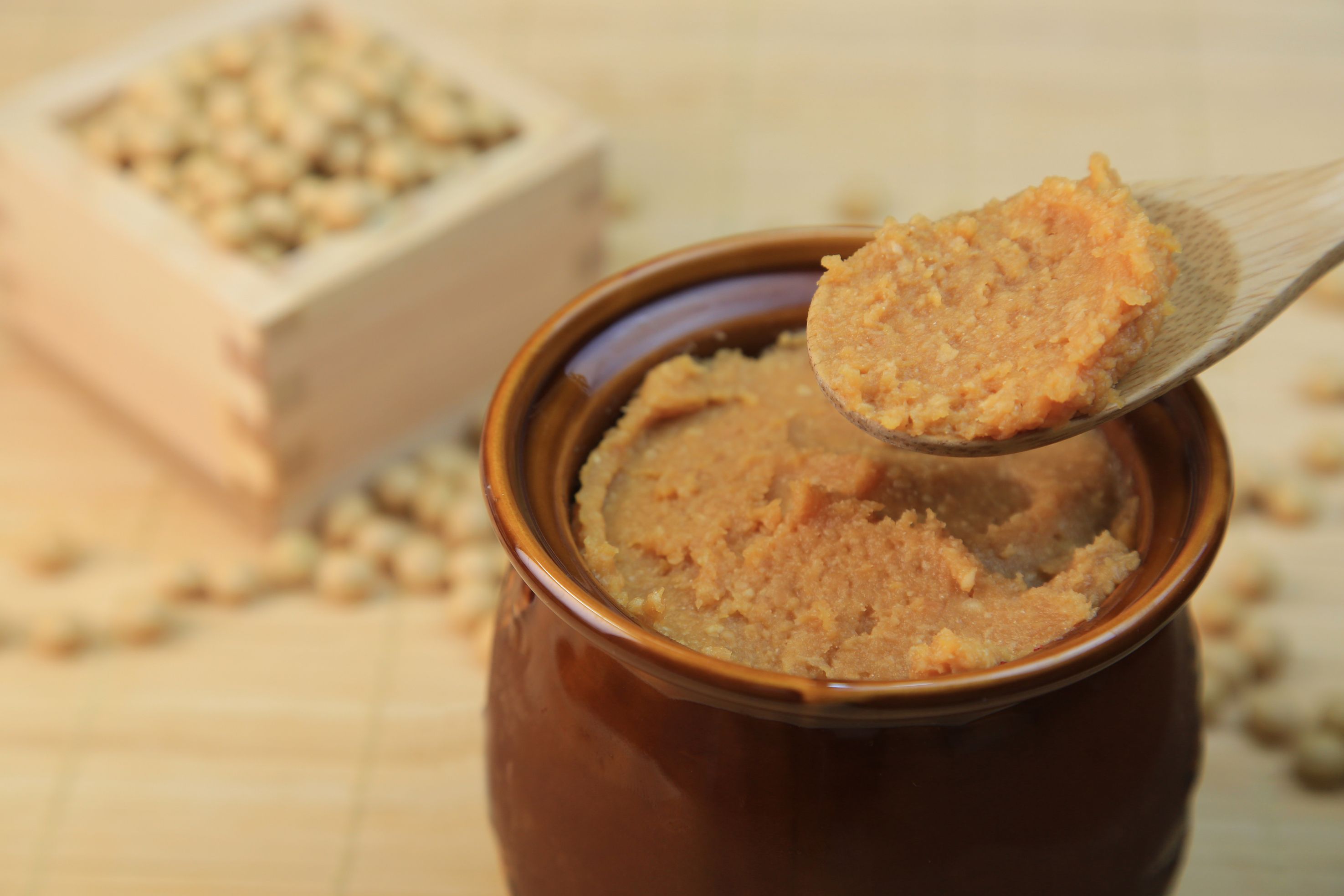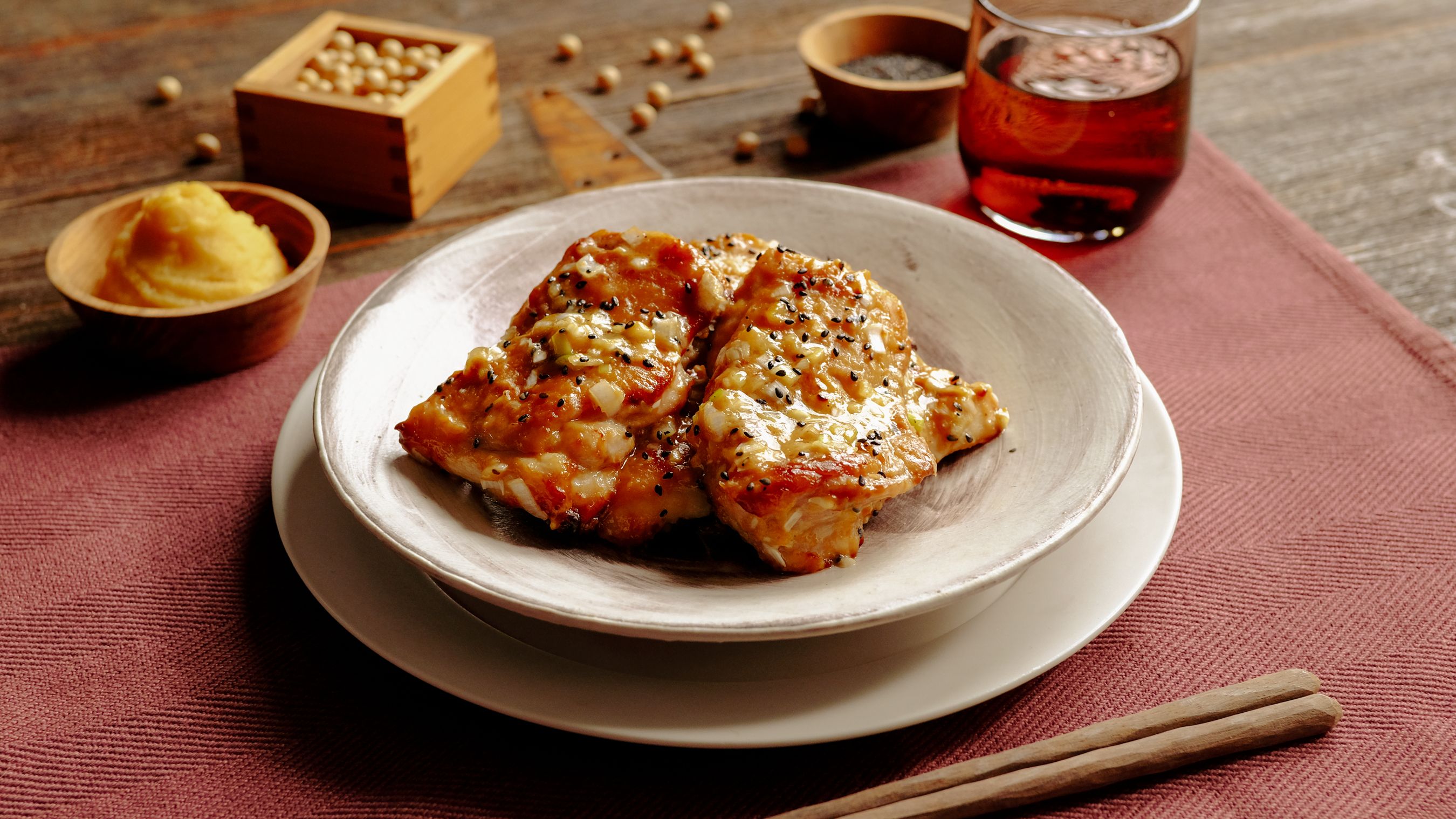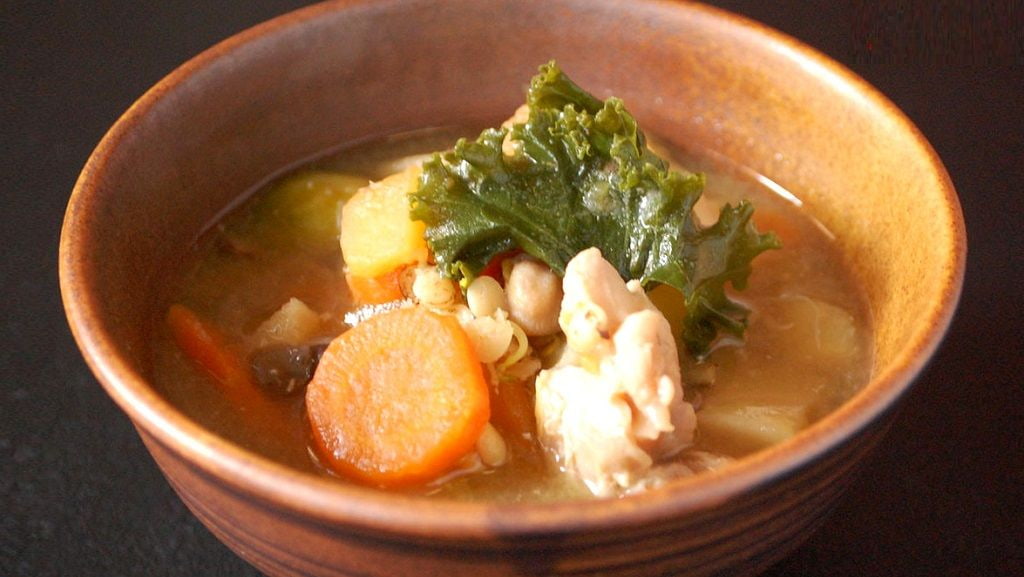
Miso, an incredibly versatile and nourishing traditional Japanese fermented food
Miso, an essential seasoning in Japanese cuisine, is a traditional fermented food that has been enjoyed across Japan since ancient times. Miso is made by mixing steamed soybeans with koji (malted rice) and salt, then fermenting the mixture slowly over a long period of time to produce a distinct savoriness and rich, smooth flavor. It is also a nutritional powerhouse, to the point where it has been credited for keeping people healthy and happy even in the dead of winter, when crops don’t grow. As such, miso is also an embodiment of the wisdom of our ancestors. And the most standard way to eat it, of course, is in the form of miso shiru (miso soup). Prepare dashi (Japanese-style stock) made with ingredients like kombu (edible kelp), niboshi (small dried fish), and katsuobushi (dried bonito flakes). Dissolve some miso into the dashi, then pop in some seasonal ingredients, and you’ll have yourself a miso shiru - a dish that has been enjoyed in Japan since ancient times. Its gentle flavor will warm you right up, in both body and soul. Miso is rich in plant protein - a fact that has garnered it considerable attention in the West in recent years, with its popularity expanding across the globe.
From a nutritional standpoint, miso is rich in the high-quality protein that includes essential amino acids, as well as carbohydrates, fats, vitamins, minerals, fiber, and other nutrients. Many studies and reports from national institutes have also shown that miso can help reduce the risk of cancer and other lifestyle diseases, prevent aging, reduce allergies, and more. Miyuki Chizuka, chef and international Chinese herbalist, says that miso is recognized in Chinese medicine for its ability to aid digestion.
“There are five primary flavors in Chinese medicine, and miso would be considered a part of the ‘sweet’ and ‘salty’ flavors. Of the five major organs, it would work on the ‘spleen,’ the ‘stomach,’ the ‘heart,’ and the ‘kidney.’ You can eat it on a daily basis and in any season, because it’s considered a ‘neutral’ food that doesn’t warm or cool the body. It aids digestion and also helps replenish the qi (vital energy in Chinese medicine) that you need to live your daily life. Miso can also help with detoxification, since the ‘salty’ flavor of miso is said to soften things that have hardened inside of the body, helping to relieve things like constipation and swelling. Miso is already very popular in the U.S., where fermented foods are very trendy right now. A lot of people put it in dressings or directly on fresh vegetables.”
There is, of course, more than one kind of miso. In fact, there are different kinds of miso produced all throughout Japan, each with their own distinct character and flavor. Miso comes in all different flavors, from those on the sweeter side to those on the salter side, depending on the amount of salt or koji used, and the ratio of the different ingredients. Some types of miso, such as aka miso from the Tokai region or shiro miso from Kyoto, are particularly expressive of regional characteristics. Chizuka recommends you start with the standard Shinshu miso, followed by the versatile Haccho miso and shiro miso, if you find yourself at a loss as to where to start.
“Haccho miso has a rich flavor and is a great seasoning that goes with all kinds of foods. In the winter season, I recommend miso nabe (Japanese-style hot pot). You can add Haccho miso to tomato paste to get a soup with a very rich flavor, kind of like demi-glace sauce. Adding ingredients like pork and potatoes can help prevent dry skin and improve digestion even more. You can also make a really delicious sauce for meat dishes by dissolving Haccho miso in simmered balsamic vinegar. Shiro miso is quite sweet, so using it to season simmered dishes like vegetable potage soup or cream stew can give these dishes a rich, mellow flavor that’s perfect for winter. Another way to use miso is to add shiro miso to yogurt, then baking it to give it a cheese-like flavor. If you’re vegan, you can make it using yogurt from alternative milks like soy milk and nut milks. Or if you’re making gratin, you can add some Shinshu miso to the heavy cream and cheese to give these winter comfort foods a bit of a Japanese flair. As you can see, you can use miso in all kinds of ways - not just in miso shiru. That’s what makes miso so great.”
Salmon Mie Cuit with Pistachios and Shiro Miso Yogurt
Put curry powder, salt, and extra virgin olive oil into a plastic bag, add salmon sashimi fillets, and marinate for 15 minutes to an hour. Combine 3 tablespoons drained yogurt, 2 teaspoons shiro miso, 1 teaspoon marmalade, a pinch of salt and pepper, and mix well to make the sauce. Arrange the salmon fillets so they are side by side, pour the sauce and pistachios on top, then bake in the pre-heated oven for about 5 minutes.
While miso goes well in all kinds of dishes and is highly versatile, there are some tricks you should know to figure out what goes best with what. The flavor you add will be different depending on the type of miso you use. And according to Chizuka, “You can’t go wrong adding a miso that’s similar in color to the dish you’re making.” Indeed, this (highly enjoyable) process of trying the many different kinds of miso and figuring out your own preferences, is only possible because of the depth and history of miso itself. Incorporate miso into various dishes in your everyday life, and you’ll feel for yourself how all-purpose the ingredient really is.
Miyuki Chizuka, chef and international Chinese herbalist
After working in Shanghai and Boston, she moved to Tokyo. Her recipes promote body and mind connection, making the most of the benefits of seasonal ingredients. She runs the Meixue cooking school. She also contributes recipes to magazines and companies and is a published columnist. Her recent publications include "Illustrated Guide to the Medicinal Herbal Lifestyle" and "Handy Guide to Stay-At-Home Cooking" (both in Japanese).
http://meixue.jp
Instagram: @miyukichizuka
Recommended recipes made with miso
Mouthwatering recipe in which miso and butter draw out the umami flavor of the chicken
Miso Butter Chicken
A hearty, everyday dish that warms both body and soul
Miso Soup with Chicken and Vegetable (Kenchinjiru)
Warm your body from the inside out during the winter season, with a miso shiru packed with root vegetables like potatoes and carrots. To make it, add your preferred miso to dashi made with kombu (kelp), katsuobushi (dried bonito flakes), etc. The key to boosting flavor is to lightly fry the chicken and vegetables in sesame oil before adding them to the soup.。
A staple Japanese household dish, loved by all
Mackerel Cooked in Miso Sauce
Sprinkle salt on the mackerel in advance to remove some of the fishy odor. Simmer the mackerel, ginger, miso, soy sauce, and mirin (Japanese rice wine) in a pot for 10 minutes. The dish can be eaten right afterwards, or left to rest for an hour so that the sweet-and-salty flavor of the sauce soaks fully into the mackerel, for even better flavor. Reheat and garnish with green onion to serve.
A winter noodle staple that warms the body and soul
Miso Ramen
Combine miso with chopped garlic, white sesame seeds, sesame oil, sugar, sake, and Worcestershire sauce, and heat up to make the miso sauce. Pan-fry thin sliced pork, cabbage, red bell pepper, and ginger, seasoning with salt and pepper to taste. Place ramen noodles in chicken broth, then add the ingredients and miso sauce to complete the dish.
Reference: Japan Miso Promotion Board (Miso Online)
Photos supplied by: amanaimages, Miyuki Chizuka
Text: Eri Arimoto










